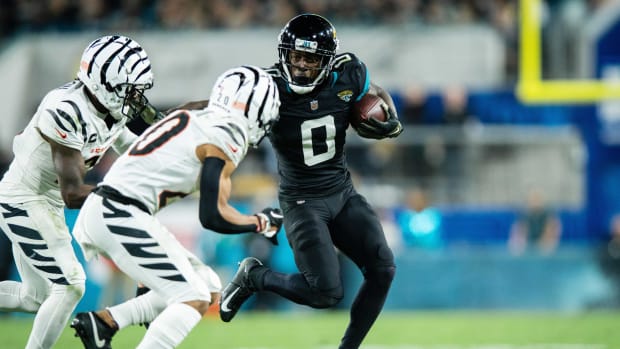Tom Brady has done his time for Deflategate, but the science says he's not guilty
Dr. John J. Leonard is Samuel C. Collins Professor in the Department of Mechanical Engineering at the Massachusetts Institute of Technology.
As Tom Brady moves on from Deflategate and returns to the field on Sunday, a lingering question remains: What amount of nefarious deflation actually occurred?
I believe it’s zero.
Surprisingly, Roger Goodell, in his rulings, never quantified the percentage of air alleged to have been illicitly removed from the footballs. If given a speeding ticket, a natural question to ask would be, “Officer, how fast was I going?”
Despite the recent statement from the scientific consulting firm Exponent defending its investigation, I am 100% convinced that there was no illegal deflation. Understanding why is a tale of two inexpensive digital pressure gauges—the so-called Logo Gauge and the Non-Logo Gauge—one of which was used by referee Walt Anderson to check the Patriots’ footballs before the AFC Championship Game on Jan. 18, 2015.
Deflategate officially comes to an end right when Patriots need Tom Brady the most
The Wells report states repeatedly that there was tampering regardless of which of the two gauges the referee used. However, in July 2015, behavioral scientist Ben Taylor pointed out a significant concern with the league’s analysis for the Logo Gauge. Figures 26, 27, and 28 were drawn incorrectly—a problem that Taylor called the master error. I will describe the issue in more detail below. The league’s analysis also assumed a pregame locker room temperature of 67°F instead of consistently applying the 71ºF temperature that it assumed for its Non-Logo gauge analysis. When the master conversion issue is corrected, and the locker room temperature assumption is applied consistently, the league’s Logo Gauge experiments and simulations fully exonerate the Patriots. There was no tampering, full stop.
This might seem like a strong claim, but in its first public statement since the Wells report was released, Exponent wrote: “We have found that across the range of criticisms, two main challenges are repeatedly made. First, our conclusion about which gauge the referee used prior to the game is incorrect.”This matches the oral arguments made before commissioner Roger Goodell in the hearing held on June 23, 2015, in which Ted Wells and the league’s experts seemed to base their case exclusively on the assertion that Walt Anderson must have used the Non-Logo Gauge, not the Logo Gauge. I think this is a big deal, and here is why.
First, a few preliminaries. When a football moves from a warm environment to a colder one, its pressure decreases. Pressure is defined as force per unit area. As the temperature of a fixed-volume vessel of gas is reduced, the average velocity of the molecules inside the vessel decreases, resulting in a proportional decrease in the magnitude of the force that the molecules of gas exert on the vessel’s walls. Put another way, the ratio of pressure to temperature is constant, if the volume and the amount of gas is held fixed. This law was first stated in the early 1800s by the French scientist Joseph Louis Gay-Lussac.
Gay-Lussac’s Law allows us to predict what the pressure levels for the footballs should have been on the field during the game. Of course, the balls warmed up somewhat at halftime while they were being measured, but the prediction from Gay-Lussac’s Law puts you in the ballpark of what should be expected and helps build your intuition to understand the issues in the case.
Roundtable: Award winners, burning questions after NFL's first quarter
In using Gay-Lussac’s Law, we have to be careful about measurement units—we need to use absolute pressure and temperature measurements, something it is hard to develop an intuition for in everyday life. At MIT, we use the metric system, but for many NFL fans I think it is easier to keep the same increment of temperature change that we use with the Fahrenheit scale. Therefore, in what follows I am using the Rankine scale, in which we need to add 459.67 degrees to measurements of temperature to reference them to absolute zero. (I am going to use 460 instead of 459.67, which is close enough for our purposes here.)
For the conditions of the 2015 AFC Championship Game, using Gay-Lussac’s law we can compute that the Patriots’ footballs should have had an on-field pressure of 11.32 psig, or pounds-per-square inch gauge pressure. This is assuming pregame inflation to 12.5 psig in a 71°F locker room, with an on-field temperature of 48°F. (With the Rankine scale, the locker room temperature was 460 + 71 = 531°R and the field temperature was 460 + 48 = 508°R.) The details of the computation are as follows (I encourage you to try it yourself with a calculator):
(12.5+14.7)*(460+48)/(460+71)-14.7 =11.32
where:
12.5 = starting Patriots’ gauge pressure in psig
14.7 = atmospheric pressure (add this to psig to get absolute pressure)
460 = add this to degrees Fahrenheit to get absolute temperature (Rankine scale)
71 = locker room temp, in degrees Fahrenheit
48 = field temperature, in degrees Fahrenheit
The ratio of the two absolute temperatures, (508°R / 531°R = 0.9567) is about 95.7%, meaning that, in absolute terms, the temperature fell by 4.3% from locker room to field. Therefore, the absolute pressure in the footballs should also fall by 4.3%, from 27.2 psi to about 26.02 psi. Subtract 14.7 psi from this last number and you get 11.32 psig, the predicted on field relative pressure for the Patriots' footballs.
Now let’s compare this prediction to the measurements. Using the Logo gauge, the values for the Patriots’ footballs were 11.80, 11.20, 11.50, 11.00, 11.45, 11.95, 12.30, 11.55, 11.35, 10.90 and 11.35 psig. The average of these values is 11.49 psig. Notice that eight of the eleven measured values are greater than the predicted pressure of 11.32 psig.
Week Under Review: Handing out awards after first quarter of 2016 NFL season
Accounting for an additional drop in pressure from some balls being wet, the agreement between prediction (11.32 psig) and observation (11.49 psig) is remarkably good. The difference of 0.17 psi is in line with the amount of warming that would be expected to occur during the measurement process, especially when one accounts for the fact that the Patriots’ footballs were kept in a bag before being measured during halftime. The agreement is especially compelling to me in light of the fact that the calibration of the cheap pressure gauges used by the referee can drift substantially over time. For example, Figure 12 in Exponent’s report shows that the calibration of the two gauges shifted in the relevant pressure range by about 0.1 psi over the course of just a few days. Figures 5 and 6 show that even brand new gauges can exhibit a pretty wide range of values when measuring the same pressure.
With such low-cost gauges, an observation of 11.49 psig and a prediction of 11.32 psig, what more could the NFL ask for? However, the NFL’s staff had no idea that this behavior was entirely accounted for based on elementary physics. Hence, the Wells/Exponent investigation was launched.
Exponent’s scientists recently stated that their findings were “comprehensive, accurate, and needed no further elaboration” and that they “have endeavored to review the criticisms of our work” but “[n]one has given us any cause to retract or qualify our findings.” This statement caught me by surprise. Given the clear description of the master error by Dean Edward Snyder at the June 2015 hearing, I had assumed that Wells and the league’s experts understood the widely held concerns with the report’s Logo Gauge analysis. For when the master error is corrected, one of the report’s main conclusions—“the Patriots halftime measurements do not appear to be explained by the environmental factors tested, regardless of the gauge used”—is contradicted.
'Drew could have died': The lasting lessons of the hit that launched Tom Brady
Respectfully, I request Dr. Robert Caligiuri, Corporate Vice President at Exponent, to review his team’s work for the Logo Gauge and to explain what seems to clearly be either an error in logic or an error in computation. In my opinion, the league’s experts should publish a correction: “If referee Walt Anderson used the Logo gauge, the Patriots halftime measurements are fully explained by the environmental factors tested under the most likely game conditions and circumstances.”
Specifically, I believe Exponent should clarify their decision not to retract or qualify their findings based on the readily apparent errors in Figures 26, 27 and 28. These figures show the transient pressure curves for the Logo Gauge measurements of the two teams’ footballs over the course of halftime. It applies a calibration conversion of the Patriots Logo Gauge values to match a more accurate “master gauge” that Exponent used in its experiments. (Exponent’s master gauge costs about $1000; Anderson’s gauges cost about $20; in measurement, cost translates to accuracy.)
As pointed out by Taylor, the calibration conversion in Figure 26 was not applied to the starting pressure. This causes the curve to be graphed about 0.3 psi too high on the page. Exponent seems to have used a value of (14.7+12.50)*(460+48)/(460+67)-14.7 = 11.52 psig for the starting pressure of the Patriots’ footballs, instead of (14.7+12.17)*(460+48)/(460+67)-14.7=11.20 psig. The value 12.17 should be used, because that is what you get when you convert a reading of 12.5 measured on the Logo Gauge to the master gauge. Failing to account for this introduces an error of 0.33 psi. Figure 26 can be further modified to repeat the computation for a 71°F locker room, in which case the master-converted starting pressure drops further to (14.7+12.17)*(460+48)/(460+71)-14.7 = 11.01 psig.
When these computations, which in my opinion are well supported by arithmetic and physics, are used to modify Figure 26, a radical change occurs: The Patriots are fully exonerated. In addition, Exponent’s game day simulations published in Table 14 of the report also show excellent agreement with the halftime measurements, if the 67°F starting temperature assumed by the league is increased to 71°F (as assumed for the Non-Logo Gauge). An increase in four degrees in the starting locker room temperature results in a 0.2 psi decrease in the starting pressure. With this modification, the numbers actually indicate an apparent inflation of 0.06 psi, for one of the measurement times listed as feasible by the league.
Overall, based on the evidence in the league’s report, I consider the case for non-tampering to be a slam dunk when the Logo Gauge is used. And recall that Walt Anderson’s best recollection is that he used the Logo Gauge.
But wait, there’s more. Although not explicitly stated in any of Goodell’s rulings, if you study the league’s report carefully, you find that the alleged increment of tampering for the case of the Non-Logo Gauge is about 0.3 psi. This might seem a lot if you are not familiar with pressure measurements, but when you do the math with the ideal gas law PV=nRT, a drop of 0.3 psi would correspond to removal of 1% of the air from the footballs. (This is computed by dividing 0.3 by 27.2, the sum of the starting pressure of 12.5 psi and the atmospheric pressure 14.7 psi.) A difference of 1% equates to being given a speeding ticket for driving 50.5 mph in a 50 mph zone.
In my opinion, this small increment of pressure loss is well within any reasonable level of measurement error, given the many assumptions in the analysis, especially given that the times of the measurements were not written down—a critical piece of information given the warming that occurred during halftime. However, it must be stressed that it was the NFL’s fault that the measurement times were not recorded, not Exponent’s—as we know, the NFL had no knowledge of Gay-Lussac’s Law or its implications before this case.
Amazingly, the alleged Non-Logo increment of deflation of 0.3 psi is not only well within the margin of error, but it also exactly matches the difference in the calibration between Walt Anderson's two pressure gauges. Engineers and scientists need to be on the lookout for such coincidences. Stephen McIntyre captured this concern well in his paper New Light on the Deflategate Controversy, which I quote: “At the Appeal Hearing, Wells spoke eloquently against coincidence (‘lightning strike’), but his own theory ultimately rests on an implausible coincidence. Theory requires that, out of all possible deflations available, the Patriots decided to deflate their footballs by the amount of bias of referee Anderson’s Logo Gauge. Wells should have been worried about his own lightning strike.” McIntyre’s paper makes a compelling argument that the Patriots’ “rubbing procedure” provides strong evidence that Anderson used the Logo Gauge.
Media Circus: Why are NFL ratings down so much?
In an ideal world, I would love to get the chance to talk through many of the details of the case with Exponent’s scientists. I am extremely curious if they have additional experimental data not included in the report—for example, did they perform simulations with the Logo Gauge with a 71°F locker room temperature? Are they willing to publish the individual ball-by-ball measured values for their simulations? Did they perform simulations that included the rubbing procedure? I can think of many questions to ask and additional experiments that would be interesting to perform.
However, based solely on the information that has been made public so far, as an engineer I am compelled to rely on the principle of Occam’s Razor, which asserts that given multiple competing hypotheses, the one that makes the fewest assumptions should be preferred. The case for tampering simply makes too many assumptions, given the excellent agreement of the Logo Gauge measurements with the predictions from the basic physics and from the simulations published in Table 14. It is not credible to posit an illicit scheme to remove 1% of the air from the footballs, resulting in a reduction in pressure of 0.3 psi. This increment is nearly impossible to detect in practice and is dwarfed by the drops in pressure that occur naturally in all NFL games played in cold weather (as described in our amicus curiae).
And by an astounding coincidence, 0.3 psi happens to also be the difference in the calibration of the two gauges that Anderson carried in his equipment bag. What are the odds that the Patriots ran an illegal scheme to remove 1% of the air from their footballs, achieving an average reduction in psi that serendipitously matches the difference between Walt Anderson’s two inexpensive pressure gauges?
I am reminded of several of the magic tricks performed recently by Philadelphia Eagles long snapper Jon Dorenbos on America’s Got Talent. In my opinion, tampering to exactly match the small difference between Anderson’s two gauges fails the test of Occam’s Razor. Therefore, I am convinced that there was no illegal deflation of the Patriots’ footballs at the 2015 AFC Championship Game—regardless of which gauge Walt Anderson used to measure the footballs.
Prof. Leonard would like to thank Ben Taylor, Nick Kistner, and Stephen McIntyre for their help and valuable insights. You can follow him on Twitter.




































